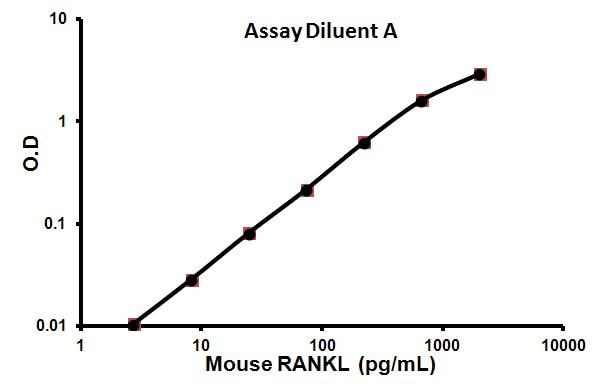Mouse RANKL ELISA Kit (TNFSF11) (ab100749)
Key features and details
- Sensitivity: 4 pg/ml
- Range: 2.74 pg/ml - 2000 pg/ml
- Sample type: Cell culture supernatant, Plasma, Serum
- Detection method: Colorimetric
- Assay type: Sandwich (quantitative)
- Reacts with: Mouse
Properties
-
Storage instructions
Store at -20°C. Please refer to protocols. -
Components 1 x 96 tests 200X HRP-Streptavidin Concentrate 1 x 200µl 20X Wash Buffer Concentrate 1 x 25ml 5X Assay Diluent B 1 x 15ml Assay Diluent A 1 x 30ml Biotinylated anti-Mouse RANKL (lyophilized) 2 vials RANKL Microplate (12 strips x 8 wells) 1 unit Recombinant Mouse RANKL Standard (lyophilized) 2 vials Stop Solution 1 x 8ml TMB One-Step Substrate Reagent 1 x 12ml -
Research areas
-
Function
Cytokine that binds to TNFRSF11B/OPG and to TNFRSF11A/RANK. Osteoclast differentiation and activation factor. Augments the ability of dendritic cells to stimulate naive T-cell proliferation. May be an important regulator of interactions between T-cells and dendritic cells and may play a role in the regulation of the T-cell-dependent immune response. May also play an important role in enhanced bone-resorption in humoral hypercalcemia of malignancy. -
Tissue specificity
Highest in the peripheral lymph nodes, weak in spleen, peripheral blood Leukocytes, bone marrow, heart, placenta, skeletal muscle, stomach and thyroid. -
Involvement in disease
Defects in TNFSF11 are the cause of osteopetrosis autosomal recessive type 2 (OPTB2) [MIM:259710]; also known as osteoclast-poor osteopetrosis. Osteopetrosis is a rare genetic disease characterized by abnormally dense bone, due to defective resorption of immature bone. The disorder occurs in two forms: a severe autosomal recessive form occurring in utero, infancy, or childhood, and a benign autosomal dominant form occurring in adolescence or adulthood. Autosomal recessive osteopetrosis is usually associated with normal or elevated amount of non-functional osteoclasts. OPTB2 is characterized by paucity of osteoclasts, suggesting a molecular defect in osteoclast development. -
Sequence similarities
Belongs to the tumor necrosis factor family. -
Post-translational
modificationsThe soluble form of isoform 1 derives from the membrane form by proteolytic processing (By similarity). The cleavage may be catalyzed by ADAM17. -
Cellular localization
Cytoplasm; Secreted and Cell membrane. - Information by UniProt
-
Alternative names
- CD254
- hRANKL2
- ODF
see all -
Database links
- Entrez Gene: 8600 Human
- Entrez Gene: 21943 Mouse
- Entrez Gene: 117516 Rat
- Omim: 602642 Human
- SwissProt: O14788 Human
- SwissProt: O35235 Mouse
- SwissProt: Q9ESE2 Rat
- Unigene: 333791 Human
see all








